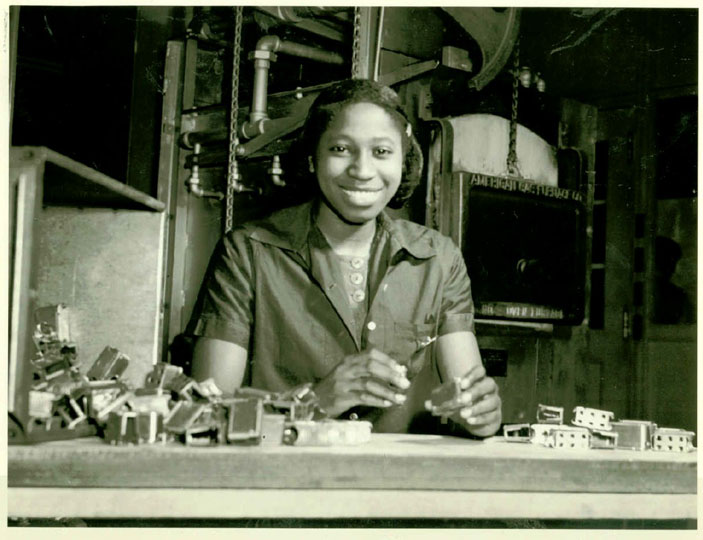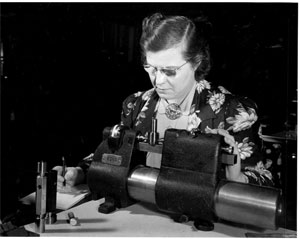|
© 2006 Kristina Winterbottom

Priscilla Bryant, a student and armory worker, inspecting M1 clips
At the outbreak of World War Two, the Springfield Armory began hiring women
and blacks to fill the positions left behind by the men going overseas. These
positions included jobs such as shop workers, and inspectors, as well as the
more stereotypical jobs such as clerical work and maintenance work. The Springfield
Armory, at this time still under government, had the crucial task of producing
arms to fight the Nazis overseas as well as helping the local economy. They began
to turn their focus to women first, and following President Franklin D. Roosevelt’s
Fair Employment Practices Committee (FEPC) plan, minorities as well.
Women held some issues when they entered the workforce. First of all, they
had to overcome the stereotypes of what “women’s work” really
was. Jobs began being labeled as “suitable” and “not suitable” for
women, as shown in a study done by the Women’s Bureau in 1942 on the “Employment
in the Manufacture of Small Arms Ammunition.” They found that jobs such
as loading and assembly or anything to do with explosives were only suitable
for men to do, but women were allowed to do some machine operation, stenciling
and painting, and sewing of bags. 1

Woman checking gages
It was not long though before women were hired to do all of the jobs needed
to fulfill the growing call for airplanes, ships, and in the case of the Springfield
Armory, ammunition. The number of women working in on the shop floor went from
a meager 14, in 1941, to 1,883 by June of 1942. Along with the shop workers,
women were also hired as inspectors, and that number showed a huge jump as well,
moving from 27 in January 1941 to approximately 792 in May of 19422
Minorities in the area were also given a step up in the work force after
FDR passed an Executive Order making discrimination in defense work illegal and
by creating the Fair Employment Practices Committee. This committee made sure
all companies contracted under the government were hiring all available personnel,
and not discriminating against able bodies willing to do the work. An example
of a loophole some companies would use was hiring blacks and other minorities
in janitorial jobs, but nothing that involved actual defense work. Because of
the FEPC, an all time high of African Americans entered in the defense work force,
making up 8% of the total force, which was up from the meager 200,000 before
the war. 3 The number employed
in the Springfield area still remained small, only 2,434 people, and their influence
on the work place in general was felt on a national scope. 4
The Springfield Armory played a crucial role in the supply of weapons to
defeat Hitler and the Nazi party. Thanks to the service of the women and minorities
who kept the factory running, it was able to pump out a huge amount of munitions.
Although often overlooked by the majority of gun enthusiasts who travel to the
Armory, specific attention is due to the workers who kept the industry at home
alive while other American boys were overseas fighting facism.
1 Gregory, Chester W. Women
in Defense Work During World War Two. 1st ed. New York: Exposition P, 1974, 109-111.
3 The Eleanor Roosevelt Papers."Fair
Employment Practices Committee." Teaching Eleanor Roosevelt, ed. by Allida
Black, June Hopkins, et. al. (Hyde Park, New York: Eleanor Roosevelt NationalHistoric Site, 2003). [Accessed
November 6, 2006].
|